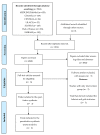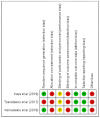Use of Virtual Reality-Based Games to Improve Balance and Gait of Children and Adolescents with Sensorineural Hearing Loss: A Systematic Review and Meta-Analysis
- PMID: 37514897
- PMCID: PMC10385194
- DOI: 10.3390/s23146601
Use of Virtual Reality-Based Games to Improve Balance and Gait of Children and Adolescents with Sensorineural Hearing Loss: A Systematic Review and Meta-Analysis
Abstract
Background: Children and adolescents with sensorineural hearing loss (SNHL) often experience motor skill disturbances, particularly in balance and gait, due to potential vestibular dysfunctions resulting from inner ear damage. Consequently, several studies have proposed the use of virtual reality-based games as a technological resource for therapeutic purposes, aiming to improve the balance and gait of this population.
Objective: The objective of this systematic review is to evaluate the quality of evidence derived from randomized or quasi-randomized controlled trials that employed virtual reality-based games to enhance the balance and/or gait of children and adolescents with SNHL.
Methods: A comprehensive search was conducted across nine databases, encompassing articles published in any language until 1 July 2023. The following inclusion criteria were applied: randomized or quasi-randomized controlled trials involving volunteers from both groups with a clinical diagnosis of bilateral SNHL, aged 6-19 years, devoid of physical, cognitive, or neurological deficits other than vestibular dysfunction, and utilizing virtual reality-based games as an intervention to improve balance and/or gait outcomes.
Results: Initially, a total of 5984 articles were identified through the searches. Following the removal of duplicates and screening of titles and abstracts, eight studies remained for full reading, out of which three trials met the eligibility criteria for this systematic review. The included trials exhibited a very low quality of evidence concerning the balance outcome, and none of the trials evaluated gait. The meta-analysis did not reveal significant differences in balance improvement between the use of traditional balance exercises and virtual reality-based games for adolescents with SNHL (effect size: -0.48; [CI: -1.54 to 0.57]; p = 0.37; I2 = 0%).
Conclusion: Virtual reality-based games show promise as a potential technology to be included among the therapeutic options for rehabilitating the balance of children and adolescents with SNHL. However, given the methodological limitations of the trials and the overall low quality of evidence currently available on this topic, caution should be exercised when interpreting the results of the trials analyzed in this systematic review.
Keywords: child; deaf; deafness; exercise therapy; exergaming; hearing impairment; motor skills disorders; rehabilitation; vestibular disease; walking.
Conflict of interest statement
The authors declare no conflict of interest.
Figures




Similar articles
-
Technological aids for the rehabilitation of memory and executive functioning in children and adolescents with acquired brain injury.Cochrane Database Syst Rev. 2016 Jul 1;7(7):CD011020. doi: 10.1002/14651858.CD011020.pub2. Cochrane Database Syst Rev. 2016. PMID: 27364851 Free PMC article.
-
E-Health interventions for anxiety and depression in children and adolescents with long-term physical conditions.Cochrane Database Syst Rev. 2018 Aug 15;8(8):CD012489. doi: 10.1002/14651858.CD012489.pub2. Cochrane Database Syst Rev. 2018. PMID: 30110718 Free PMC article.
-
Education support services for improving school engagement and academic performance of children and adolescents with a chronic health condition.Cochrane Database Syst Rev. 2023 Feb 8;2(2):CD011538. doi: 10.1002/14651858.CD011538.pub2. Cochrane Database Syst Rev. 2023. PMID: 36752365 Free PMC article.
-
Virtual reality for rehabilitation in Parkinson's disease.Cochrane Database Syst Rev. 2016 Dec 21;12(12):CD010760. doi: 10.1002/14651858.CD010760.pub2. Cochrane Database Syst Rev. 2016. PMID: 28000926 Free PMC article.
-
Exercise for haemophilia.Cochrane Database Syst Rev. 2016 Dec 19;12(12):CD011180. doi: 10.1002/14651858.CD011180.pub2. Cochrane Database Syst Rev. 2016. PMID: 27992070 Free PMC article.
Cited by
-
Postural Sway Velocity of Deaf Children with and without Vestibular Dysfunction.Sensors (Basel). 2024 Jun 15;24(12):3888. doi: 10.3390/s24123888. Sensors (Basel). 2024. PMID: 38931672 Free PMC article.
-
Effectiveness of the aquatic physical therapy exercises to improve balance, gait, quality of life and reduce fall-related outcomes in healthy community-dwelling older adults: A systematic review and meta-analysis.PLoS One. 2023 Sep 8;18(9):e0291193. doi: 10.1371/journal.pone.0291193. eCollection 2023. PLoS One. 2023. PMID: 37683025 Free PMC article.
-
Vestibular Infant Screening-Rehabilitation (VIS-REHAB): protocol for a randomised controlled trial on Vestibular Rehabilitation Therapy (VRT) in vestibular-impaired children.BMJ Open. 2024 Dec 20;14(12):e085575. doi: 10.1136/bmjopen-2024-085575. BMJ Open. 2024. PMID: 39806605 Free PMC article.
-
How to Help Deaf Children Who Do Not Understand Their Vestibular Symptoms and Motor Disorders as Abnormal?J Audiol Otol. 2024 Oct;28(4):314-317. doi: 10.7874/jao.2024.00045. Epub 2024 Jul 9. J Audiol Otol. 2024. PMID: 38973322 Free PMC article. No abstract available.
-
Sports-Related Injuries in Deaf Competitive Squad Athletes-Results of a Retrospective Self-Assessment.Sports (Basel). 2025 Feb 6;13(2):43. doi: 10.3390/sports13020043. Sports (Basel). 2025. PMID: 39997974 Free PMC article.
References
-
- Smith A. Preventing deafness—An achievable challenge. The WHO perspective. Int. Congr. Ser. 2003;1240:183–191. doi: 10.1016/S0531-5131(03)00960-9. - DOI
Publication types
MeSH terms
LinkOut - more resources
Full Text Sources
Medical
Miscellaneous

